Chapter Seven Diagnose Before You Prescribe
Seven Diagnose Before You Prescribe
Overview
Stephen Covey tells a powerful story in his best-selling book, The 7 Habits of Highly Effective People. It’s worth repeating here verbatim.
When our daughter Jenny was only two months old, she was sick one Saturday, the day of a football game in our community that dominated the consciousness of almost everyone. It was an important game—some 60,000 people were there. Sandra and I would like to have gone, but we didn’t want to leave little Jenny. Her vomiting and diarrhea had us concerned.
The doctor was at that game. He wasn’t our personal physician, but he was the one on call. When Jenny’s situation got worse, we decided we needed some medical advice.
“This is Mrs. Covey, Doctor, and we’re concerned about our daughter, Jenny.”
“What’s the situation?” he asked.
Sandra described the symptoms, and he said, “Okay. I’ll call in a prescription. Which is your pharmacy?”
When she hung up, Sandra felt that in her rush she hadn’t really given him full data, but that what she had told him was adequate.
“Do you think he realizes that Jenny is just a newborn?” I asked her.
“I’m sure he does,” Sandra replied.
“But he’s not our doctor. He’s never even treated her.”
“Well, I’m pretty sure he knows.”
“Are you willing to give her the medicine unless you’re absolutely sure he knows?”
Sandra was silent. “What are we going to do?” she finally said.
“Call him back,” I said.
“You call him back,” Sandra replied.
So I did. He was paged out of the game once again. “Doctor,” I said, “when you called in that prescription, did you realize that Jenny is just two months old?”
“No!” he exclaimed. “I didn’t realize that. It’s good you called me back. I’ll change the prescription immediately.”
His story drives home an important lesson: it’s important to diagnose before you prescribe. Had Stephen Covey’s young daughter received the wrong medicine, something terrible might have happened. Covey’s story applies also to selling: it’s important to diagnose customers’ problems and then offer appropriate solutions.
SOLUTION SELLING PRINCIPLE DIAGNOSE BEFORE YOU PRESCRIBE
Experience teaches us a lot of things, but sometimes experience can get in our way. I’m reminded of a study that tracked the performance of several hundred new salespeople. It found that as new salespeople become more familiar with their products and with selling itself, performance typically goes up. Morale climbs too. However, several months into most sales careers, sales performance falls off, and when that occurs, morale soon follows. Figure 7.1 illustrates this sales performance dilemma.
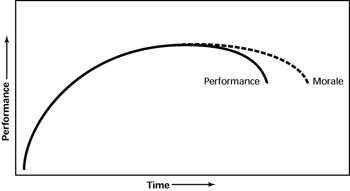
Figure 7.1: Sales Performance over Time
The big question is this: Why the drop in performance? Most people think the reason is burnout or some other motivational factor. However, research has identified the problem as behavioral, something the salespeople were doing that caused this problem—actually, it was something they were not doing. The more experience salespeople gain, the more likely they are to stop asking as many questions. Since most new salespeople don’t know much about what they’re selling, they’re forced to ask a lot of questions. However, as they gain experience, everything changes, and not always for the good. Salespeople become experts; they think they’ve seen this situation before. So when the buyer admits a problem, instead of taking time to diagnose the problem, they jump straight to prescribing a solution (telling their buyers what they should do). The salesperson’s enthusiasm and expertise become his or her own worst enemy.
It’s like the physician in Stephen Covey’s story who gave a prescription before fully diagnosing the situation. The key is to do a good job diagnosing your buyer’s problem. If buyers don’t trust your diagnosis, they won’t trust your prescription. It’s probably fair to say that the confidence a buyer has in a prescription is proportional to how thorough your diagnosis is.
This chapter introduces you to a conversation model that will help you diagnose buyer pains, uncover reasons for those pains, explore the impact of the problem throughout the buyer’s organization, and create visions of solutions that match your company’s capabilities. It’s called the 9 Block Vision Processing Model (also called the 9 Boxes or the 9 Block Model), and it is one of the cornerstones of Solution Selling.
Tens of thousands of salespeople, consultants, and businesspeople use this model in many different cultures and industries (technology, financial services, telecommunications, utilities, and health care, to name a few). Many people use it in their everyday lives, not just in their business lives, because it’s so practical, useful, and user-friendly.
THE 9 BLOCK VISION PROCESSING MODEL
Situational experts and some Eagle salespeople have an innate talent for diagnosing problems and creating visions of solutions in the minds of their buyers. They instinctively ask questions that build rapport, help them understand the problem and the reasons, and lead buyers to solutions that use their products and services. Most of us who aren’t particularly intuitive, or lack situational expertise, need a job aid, one that helps us emulate experts. The 9 Block Vision Processing Model helps salespeople do this.
It’s a straightforward model, one that can be used in a variety of ways, and it’s easily learned. Before you learn to use it for either Vision Creation (Chapter Eight) or Vision Reengineering (Chapter Ten), I want you to understand the conversation strategies in the model. Let’s take baby steps before running the race (see Figure 7.2).
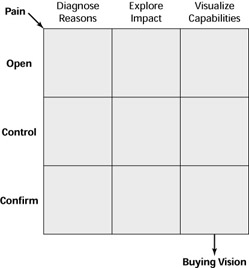
Figure 7.2: The 9 Block Vision Processing Model
First, three different kinds of questions are used in the model:
- Open questions
- Control (closed) questions
- Confirming questions
Second, there are three main areas to investigate:
- Diagnose reasons for the pain (problems)
- Explore impact (throughout the organization) of the problems
- Visualize the capabilities needed to solve the problems
As you can see in Figure 7.2, once you integrate the three rows and the three columns that form the 9 Boxes, it creates a matrix that makes remembering and using the model much easier.
Let’s go through the model in detail.
THREE QUESTION TYPES
The 9 Block Model uses three different types of questions: open, control (closed), and confirming questions. I often refer to these three question types as Questioning Etiquette 101.
Open Questions Open or open-ended questions do several things. They invite buyers to talk freely (hopefully about the pain they just admitted) and respond from their experience, knowledge, and points of concern, and they earn salespeople the right to ask control questions.
Empathetic, sincere, open-ended questions are comfortable for buyers. They can answer these questions any way they want. Buyers can demonstrate their expertise and express their feelings. Buyers usually respond well to open-ended questions because they’re nonthreatening, especially if the buyer has already admitted pain.
Open-ended questions do have one disadvantage. The salesperson gives up control and buyers can go anywhere they want, and many times they do. That’s not good if the direction they take has nothing to do with your strengths or capabilities. But early in the buying process, it’s important for buyers to feel comfortable, so salespeople are best advised to start with open questions such as, “Why do you think you’re having this difficulty?”
Control Questions Control questions are basically the same as closed or closed-ended questions. We prefer to use the term control question because it better describes the approach we’re asking you to use. Closed questions tend to be answered with a yes or no, whereas control questions tend to elicit more complete responses. Control questions might be, “Is it because . . . ? If it is, how much or how often?” Control questions guide the buyer in the direction you want your diagnostic conversation to go. Control questions seek specific pieces of infor-mation in specific areas. They help diagnose, lead, and develop the buyer’s vision.
You have to be careful with control questions because buyers may start to feel uncomfortable. You must be alert and watch for this and adjust your approach according to the verbal and nonverbal feedback you receive from the buyer. If your buyer shows signs of discomfort, you may be controlling too much. Relax the situation and revert to some open-ended questions. Then, once you feel rapport is back, return to your control questions.
Research has revealed an interesting statistic. The ratio of control questions to open questions for high-achieving salespeople is three to one; it’s one to three for average and below-average salespeople. What does that tell us? The very best salespeople learn to use control questions to diagnose problems and lead buyers to a vision that helps both the buyer and the salesperson.
Confirming Questions Confirming questions ensure that both the buyer and the salesperson are in sync. An example of a confirming question is, “So from what I’ve just heard, you said . . . Did I understand that correctly?” Confirming questions summarize the salesperson’s understanding of the buyer’s responses. The salesperson demonstrates an ability to listen and show empathy and exhibits his or her expertise. Good confirming questions help cast a halo around the salesperson. They show the buyer you understand his or her situation. Buyers want to do business with people who understand them. Confirming questions can also help rectify any misunderstanding that may have occurred during the dialogue. It’s better to find that out sooner rather than later.
THREE KEY AREAS TO INVESTIGATE
After pain is admitted, there are three key areas we want salespeople to investigate: Diagnose Reasons, Explore Impact, and Visualize Capabilities. First, you need to find the reasons for the pain. Second, it’s imperative to explore how the pain affects or impacts the organization. You need to find out not only who is impacted, but how and by how much. The idea is to connect as many people to the problem as possible. Third, now that you know the reasons for the pain and its impacts, it’s time to create a vision of a solution—help the buyer to visualize (in simple terms) the capabilities he or she needs to solve the problem.
Diagnose Reasons
After the buyer has admitted having a pain, the salesperson’s job is to diagnose the reasons for the pain before exploring impacts or trying to create a vision of a solution. Figure 7.3 shows how salespeople diagnose the reasons for the pain by asking the appropriate open, control, and confirming questions. The graphic depicts this concept by highlighting the area on which to focus.

Figure 7.3: Diagnose Reasons
Box 1: Open Question, Reasons for Pain In Box 1 of the model, the salesperson’s job is to use an open-ended question and ask about the reasons for the pain; for example, “Tell me, what are the reasons you’re not able to . . . ?”
This type of question encourages buyers to talk about the reasons for their problems. Some buyers respond with a detailed summary. But most buyers only provide general information at this point, forcing the salesperson to explore the situation further using control questions.
Box 2: Control Question, Reasons for Pain In Box 2, the salesperson has to diagnose the reasons for the pain and to measure the pain as much as possible. You establish your personal credibility and the value of your products and services in this box. If rapport and sufficient trust have been established, buyers usually answer the salesperson’s control questions. Most of the salesperson’s time in the diagnosing reasons area is spent in this box. Without a doubt, this is the most important box in the model. Examples of diagnostic questions are: “This [pain], is it because . . . ?” Or is it because . . . ?” “How much is [this pain] costing you?”
Box 3: Confirming Question, Reasons for Pain In Box 3, the salesperson’s job is to make sure he or she is aligned with the buyer by confirming the buyer’s previous responses. You want buyers to see you as patient and willing to attend to details. It’s important for buyers to believe that you really do understand their issues. A way to confirm might be to say, “So, as I understand it, the reasons for your [pain] are . . . . Is that correct?”
Explore Impact
After pain is admitted and the reasons are discovered, then exploring the impact of the pain throughout the organization is essential. Impact questions are powerful because their answers reveal how far the problem extends into different parts of the organization, which then reveals how interdependent these parts are (see Figure 7.4).
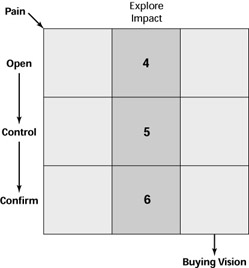
Figure 7.4: ExploreImpact
Questions that explore impact frequently reveal the raw emotions behind the pain. Salespeople can broaden a critical issue to include many more people in the buyer’s organization. Furthermore, such questions can give you clues about where the real power exists in the organization. Look at the middle column in Figure 7.4. Now imagine the buyer’s organization chart. That’s a good way to visualize this column.
Inexperienced as well as experienced salespeople sometimes forget to diagnose this area of vital information for two reasons: (1) their situational knowledge—knowing where the impacts are—is limited and (2) this area of questioning is not a regular part of their sales process.
Box 4: Open Question, Explore Impact Here your job is to use an open-ended question to explore the impacts of the pain; for example, “Tell me, besides yourself, who else in your organization is impacted by this pain and how are they impacted?” This type of open-ended question encourages the buyer to think about what other people in the organization is affected by the pain. The buyer may not always know, so you may have to explore the situation further using control questions.
Box 5: Control Question, Explore Impact Now you have to explore the impact of the pain throughout the organization. Ask, “If you’re in pain, does this mean that your . . . is not able to . . . ? If that’s the situation, wouldn’t it also mean that . . . is probably experiencing . . . as well?” Here’s your chance to discover where and how the pain spreads throughout the organization. Who’s involved? Who’s connected to whom? Who’s relying on whom to fix the problem? Who are the stakeholders? Is it all internal? External? What about stock price? Earnings? Profits? Sales revenue? Operating costs? HR costs? Internet costs? Regulatory compliance?
Box 6: Confirming Question, Explore Impact In Box 6, the salesperson makes sure that he or she is in alignment with the buyer by confirming all the buyer’s responses. For example, ask, “So, as I understand it, [restate the pain] that we have been discussing is not only impacting you, but it is also having an impact on . . . as well as . . . . So, it’s not just your problem, it’s more of a companywide problem. Is that correct?”
Visualize Capabilities
Up to this point, you’ve worked hard to diagnose the problem and explore the impacts, but it could all be for naught if you can’t participate with the buyer in creating a vision of how to solve the problem. Developing needs and creating visions are skills that you must develop to facilitate Solution Selling. An important aspect of creating a vision of a solution is ownership. In other words, it’s not doing you a lot of good to have the vision. What’s important is for the buyer to have the vision and take ownership of a solution for the problems that have been diagnosed.
You must create visions for buyers. Not all salespeople are able to create a good vision of a solution, but this can be learned. I know it’s possible to learn, because we teach people to do it every day. With practice, most salespeople can do it well. That’s really what this model is designed to do. There’s no trickery. These are just good consultative questions that enable buyers to see the vision for themselves.
A key to helping create visions in the minds of buyers is having good situational knowledge, including business acumen, good capability knowledge, and the ability to ask good questions (see Figure 7.5).
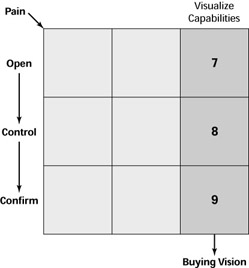
Figure 7.5: VisualizeCapabilities
Box 7: Open Question, Visualize Capabilities In Box 7, your job is to use an open-ended question to explore the buyer’s vision of the capabilities needed to solve the pain. For example, ask, “What will it take for you to solve this problem?” Please note that in this example, we specifically use the word you in the question to achieve two things. We want to (1) know whether this person already has a vision (possibly one that competes with yours) and (2) determine if this person is willing to take ownership of the problem that’s just been diagnosed. Until the buyer takes ownership of the problem, nothing good will happen.
Again, as in Boxes 1 and 4, this type of open-ended question encourages buyers to think on their own; their answers give us insight into what is on their minds. Once we have the buyers’ thoughts about a solution, it’s time to support, expand, or change their vision using control questions centered on your company’s capabilities. The transition from open to closed questions is achieved by simply asking, “May I try a few ideas?”
Box 8: Control Question, Visualize Capabilities Box 8 is the second most important box in the Solution Selling 9 Block Vision Processing Model. It’s second only to Box 2, which uses control questions to diagnose reasons for the pain. Remember that if you didn’t discover reasons for the problems, you won’t be in a position to create capability visions to help the buyer solve the problems.
An analogy is the game of bowling. Bowling pins are set up one behind the other and are knocked down by the impact of the bowling ball. In Box 2, we set up the reasons—that is, the bowling pins—and in Box 8, we use capabilities—the bowling ball—to knock them over.
In Box 8, use control questions to create visions that match the capabilities of your products and services. You accomplish this by painting word pictures that enable buyers to see themselves or other people in their company solving problems with your capabilities. For example, ask, “What if . . . when you had to . . . you could . . . . Would that help?” or “Earlier, you mentioned one of the reasons for [the pain] was when your . . . has to . . . . Would it help if they could . . . ?”
Box 9: Confirming Question, Visualize Capabilities Finally, you have to make sure you’re aligned with the buyer by confirming the buyer’s vision. This is particularly important because you’ll want to confirm your buyer’s vision in writing as part of controlling the ongoing sale. Here’s an example: “So, as I understand it, if you had the ability to . . . when . . . occurs, you believe you would be able to solve the problem that we’ve been discussing. Is that correct?”
You now have a buying vision. Buyers can see themselves solving their own problems with the help of your products and services.
HOW TO GAIN SITUATIONAL FLUENCY
What’s difficult about this questioning model? Few people have difficulty asking open-ended questions, because they’re general and nonthreatening to the buyer; for example, “What are the reasons? Who else is affected? What is it going to take for you to solve this problem?” And few people have trouble asking confirming questions, because anyone who has listened and taken a few notes can repeat back what he or she has heard from the buyer.
The difficult part is asking the control or closed-ended questions. They require salespeople to have situational knowledge and business acumen. When reviewers first studied this model, they said, “You have a great model, but our salespeople don’t have the knowledge to ask the right control questions.” You may be thinking the same thing. If so, relax: we’ve developed a job aid for sales and marketing people to use. It’s called a Pain Sheet. It was designed specifically to help salespeople formulate control questions (the middle row of boxes) within Solution Selling’s 9 Block Vision Processing Model. Good Pain Sheets can help salespeople develop situational fluency.
The Pain Sheet, or the Situational Fluency Prompter
The Pain Sheet, or the Situational Fluency Prompter, documents specific control questions for salespeople to use when diagnosing buyer pains and creating buying visions. Imagine, before making a sales call, having a repository of information available to you that would identify the following:
- The pains of the person you’re calling on
- The reasons for those pains
- The areas of impact to his or her organization
- The capabilities that your company offers to help solve the pain
This job aid and sales tool has become a standard communication document between marketing and sales in many of the world’s best companies. Companies use the Pain Sheets in several ways: to help salespeople facilitate the diagnostic conversation (via the 9 Blocks), develop their product and situational knowledge, launch new products and revamp their product training, facilitate industry and product information updates, teach nonsalespeople how to have meaningful conversations, and enable the entire company to focus on providing solutions.
Figure 7.6 is a completed Pain Sheet. This Pain Sheet is a fictitious one developed for our salesperson, Bill Hart, to use during his diagnostic conversation with the VP Sales at Titan Games, Inc. In this example, the pain of the buyer is “missing new account revenue goals.” Bill Hart’s organization sells everything from e-commerce software to the hardware and services that support it. As you study this Pain Sheet, notice that the products or services are never mentioned. On the other hand, the capabilities of the business application and supporting hardware are. The Pain Sheet leverages the knowledge base of a company.
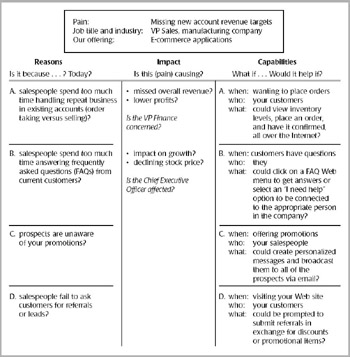
Figure 7.6: Pain Sheet (Situational Frequency Prompter)—Example
Imagine if you could go to your computer and bring up a Pain Sheet covering the industry, the job title, and the pains of the person you’re going to call. Imagine the competitive edge this would give you. Most companies have this information, but salespeople can’t access it or lack a vehicle or sales process to organize it and use it effectively. A Pain Sheet is that vehicle—it collects and organizes the information that salespeople need to have meaningful conversations.
Where in the Solution Selling 9 Block Vision Process Model does a Pain Sheet fit? It fits in the middle row, the control section of the nine boxes. Figure 7.7 illustrates this.

Figure 7.7: The Pain Sheet and the 9 Boxes
Who should have the responsibility for building Pain Sheets and leveraging the valuable knowledge bases of companies? First, if you’re a salesperson and responsible for a sales quota, take responsibility for building Pain Sheets. (Alternatively, at least take responsibility for overseeing that they’re being done and maintained.) Building Pain Sheets isn’t difficult. Start with your top five selling scenarios and build Pain Sheets to support those sales situations.
Many companies develop this valuable sales aid through their marketing departments or through the product marketing groups. We have clients today who insist that Pain Sheet information be made available at the same time their new products and services go on the market. Sales managers reason that if their salespeople don’t have this information, they will resort to only talking about the features and functions of the new product. And doing so will give buyers more reasons not to buy than to buy. Stop this insanity and start using Pain Sheets. Leverage your company’s entire knowledge base.
In the next chapter, I take a step-by-step approach and show you how to have an actual conversation using the model.
Part One - Solution Selling Concepts
Part Two - Creating New Opportunities
- Chapter Four Precall Planning and Research
- Chapter Five Stimulating Interest
- Chapter Six Defining Pain or Critical Business Issue
- Chapter Seven Diagnose Before You Prescribe
- Chapter Eight Creating Visions Biased to Your Solution
Part Three - Engaging in Active Opportunities
Part Four - Qualify, Control, Close
- Chapter Eleven Gaining Access to People with Power
- Chapter Twelve Controlling the Buying Process
- Chapter Thirteen Closing: Reaching Final Agreement
Part Five - Managing the Process
EAN: N/A
Pages: 106
